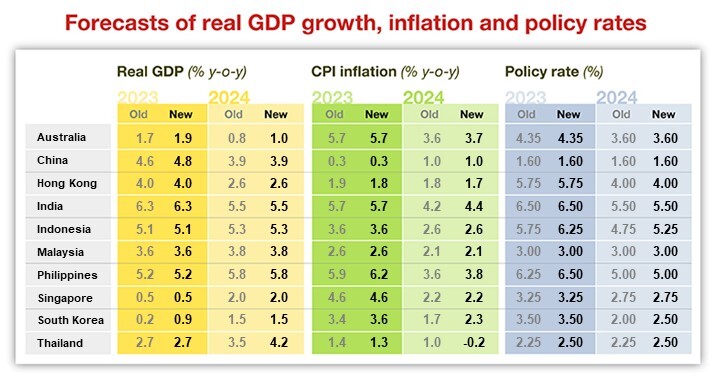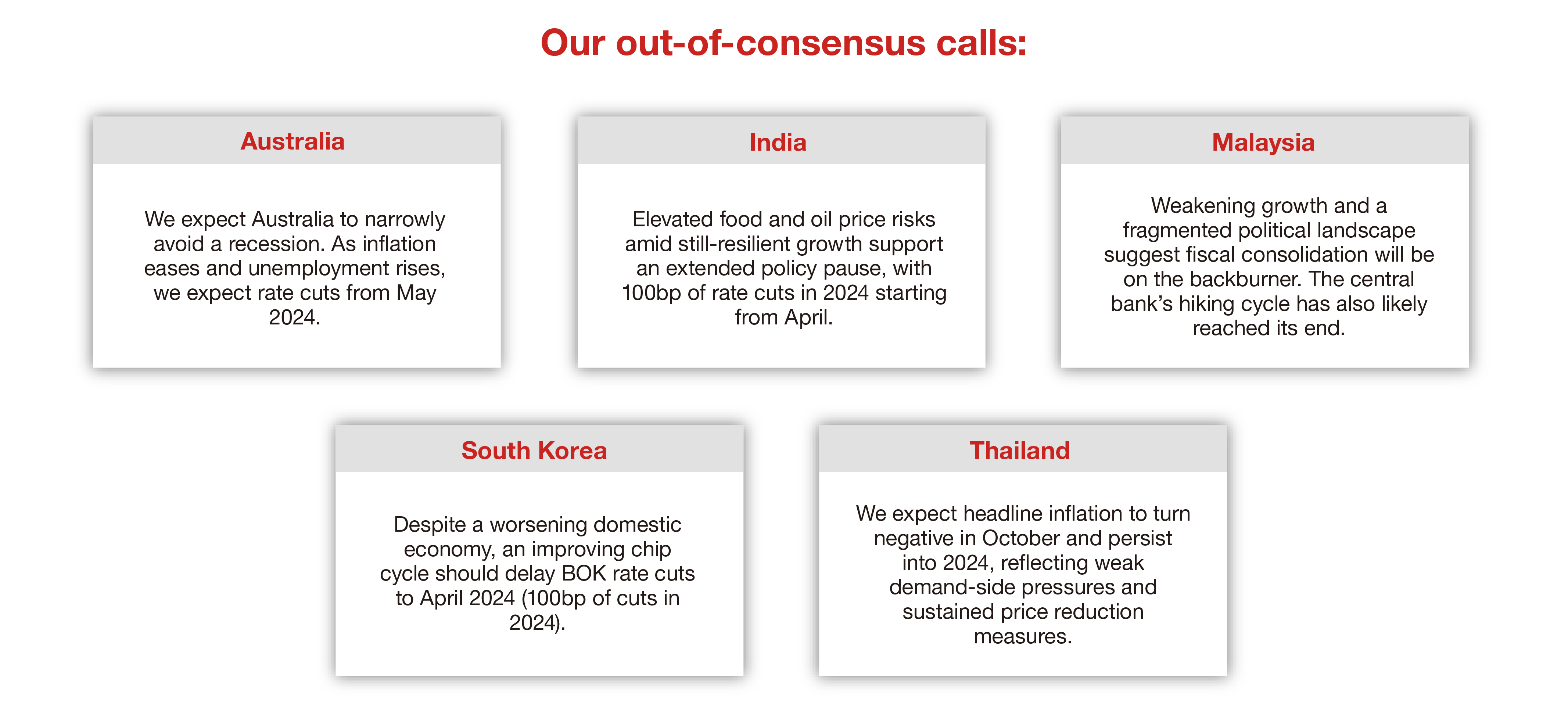
Asia Economic Monthly: The goods cycle is headed higher for now
Asia’s goods cycle has bottomed out and is headed higher over the next two quarters.
- Goods inventory remains high, as consumers prefer to spend on services.
- Price effects could shift to becoming a tailwind for exports.
- Asia’s export growth in 2024 could be better than in 2023.
A muted global growth outlook usually reflects negatively on the goods cycle, but data on Asia’s shipments, inventory and production indicate that the worst may be behind us.
The goods and services cycles have diverged following the pandemic. Despite an aggressive global rate hiking cycle, services have stayed resilient. Goods, which experienced a boom during the pandemic, have since tumbled. The decline in goods sales is due to higher inflation, the bullwhip effect for semiconductors, weaker China demand and a shift in global demand to services.
There is growing evidence that this goods cycle downturn in Asia has bottomed out and could be on course to recover, according to Nomura’s analysis. Korea’s industrial production data show a manufacturing recovery in August and improvements in daily average export growth in September. Export growth is also increasing in the assembly hub of Vietnam.
Though shipments have stabilized, the inventory of goods remains high. Chip inventories in South Korea, for example, remain elevated, despite big tech’s production cuts, though they could decline in coming months. Inventory of chemical and basic metals is closer to normal, while it remains high for electrical equipment and Thailand autos. High inventory and destocking, a process to reduce on-hand inventory, may drag on growth over the next two quarters.
Historically, production and export shipment growth have moved in tandem. However, since inventory levels are high, some of the initial demand will be fulfilled by drawing down inventory rather than ramping up production. As such, production could lag export shipments slightly. That said, demand conditions are the more important leading indicator for the goods production cycle. An improvement in new orders would confirm that the manufacturing downturn has bottomed out. Production should improve with a lag.
Looking ahead, price effects could shift to become a tailwind for exports. Asia’s export values, which declined by 14% year-on-year in June, have fallen more sharply than the 4% export volume drop, reflecting lower memory chip prices and a reduction in other commodity prices, such as oil, coal, palm oil and liquefied natural gas. If oil prices remain at current elevated levels, price effects could boost exports of petroleum products, chemicals and petrochemicals over the coming months.
The global growth outlook remains uncertain, the cost of capital is high and financial conditions are tightening. Such an environment is often negative for the goods cycle, but Asia has already experienced a deep downturn in its goods sector. Our analysis of data on Asia’s shipments, inventory and production signals that the downturn has bottomed out and a recovery is looking more likely. Factors such as stabilization in China, positive price effects for semiconductors and restocking demand for consumer goods verticals could lift exports and manufacturing output growth in Asia’s more open economies, at least over the next two quarters.
The bigger question is whether this upcycle can be sustained. We expect a synchronized global growth downturn: mild recessions in the US, Europe and Japan, amid stable growth in China. This could weigh on Asia’s exports of capital and consumer goods, and we cannot rule out a setback in final demand. However, we expect these recessions to be mild. If this turns out to be the case, Asia’s export growth in 2024 could be better than in 2023, with the worst of the exports and manufacturing contraction likely behind us.

For more on our 2023 growth projections, read our full report.
Contributor

Sonal Varma
Chief Economist, India and Asia ex-Japan

Si Ying Toh
Economist, Asia ex-Japan
Disclaimer
This content has been prepared by Nomura solely for information purposes, and is not an offer to buy or sell or provide (as the case may be) or a solicitation of an offer to buy or sell or enter into any agreement with respect to any security, product, service (including but not limited to investment advisory services) or investment. The opinions expressed in the content do not constitute investment advice and independent advice should be sought where appropriate.The content contains general information only and does not take into account the individual objectives, financial situation or needs of a person. All information, opinions and estimates expressed in the content are current as of the date of publication, are subject to change without notice, and may become outdated over time. To the extent that any materials or investment services on or referred to in the content are construed to be regulated activities under the local laws of any jurisdiction and are made available to persons resident in such jurisdiction, they shall only be made available through appropriately licenced Nomura entities in that jurisdiction or otherwise through Nomura entities that are exempt from applicable licensing and regulatory requirements in that jurisdiction. For more information please go to https://www.nomuraholdings.com/policy/terms.html.




